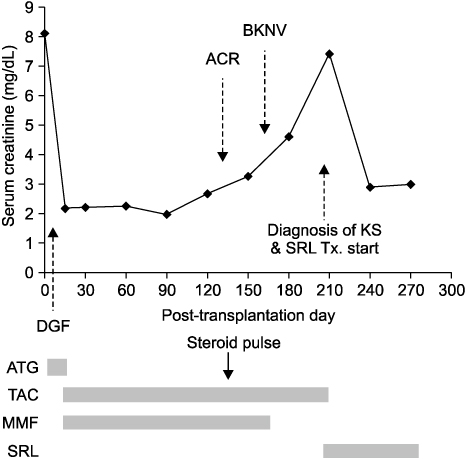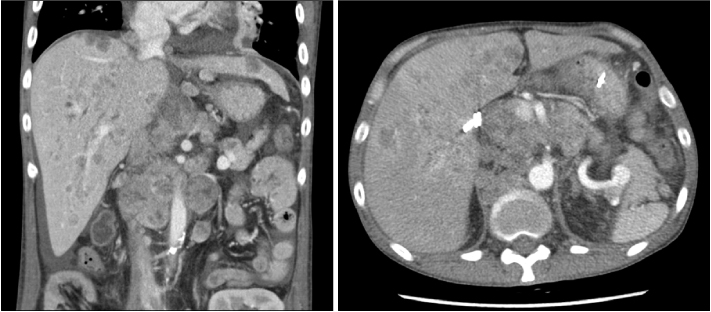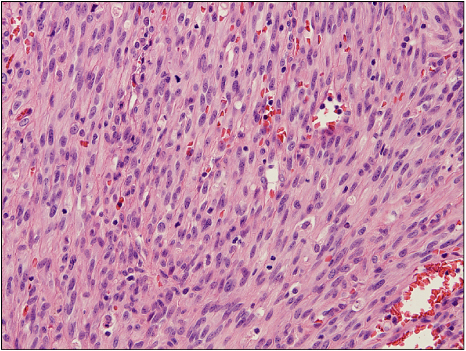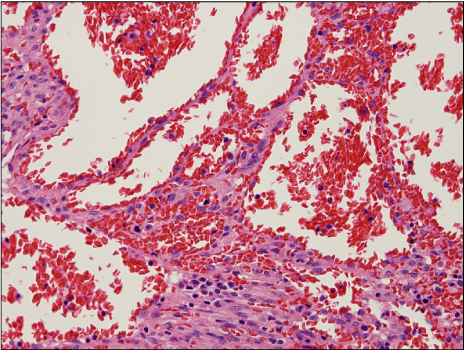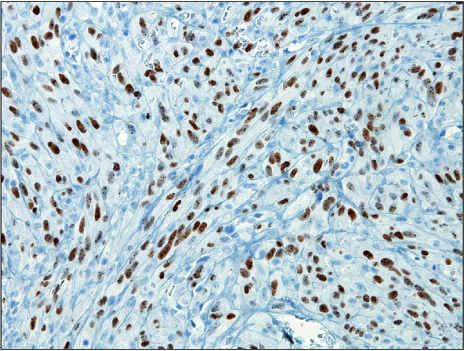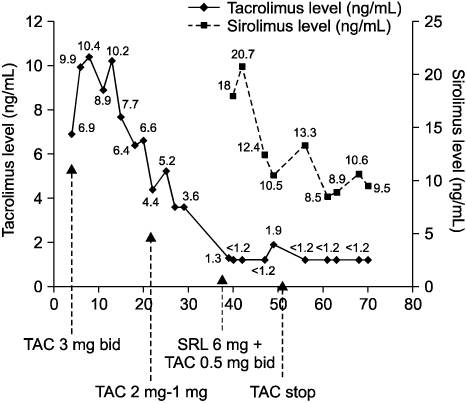J Korean Soc Transplant.
2012 Dec;26(4):293-298. 10.4285/jkstn.2012.26.4.293.
Successful Sirolimus Treatment of Multiple Visceral Kaposi's Sarcoma in a Renal Allograft Patient
- Affiliations
-
- 1Division of Medical Oncology, Department of Internal Medicine, Severance Hospital, Yonsei University College of Medicine, Seoul, Korea. SOCMED@yuhs.ac
- 2Department of Surgery, Severance Hospital, Yonsei University College of Medicine, Seoul, Korea.
- 3Department of Pathology, Severance Hospital, Yonsei University College of Medicine, Seoul, Korea.
- 4Division of Nephrology, Department of Internal Medicine, Severance Hospital, Yonsei University College of Medicine, Seoul, Korea.
- KMID: 2202433
- DOI: http://doi.org/10.4285/jkstn.2012.26.4.293
Abstract
- The use of immunosuppressant's increases the risk of developing malignancies in renal allograft patients. One of the most important malignancies, Kaposi's sarcoma, can cause mortality and graft failure among renal allograft patients. We report the case of a 39-year-old male diagnosed with multiple visceral Kaposi's sarcoma 6 months after a second cadaveric renal allograft. The patient's renal function was markedly deteriorated at admission and required hemodialysis initially. Radiologic studies revealed Kaposi's sarcoma in multiple lymph nodes, liver, lung, and peritoneum. The excisional biopsy of an inguinal lymph node confirmed this diagnosis. After diagnosis, tacrolimus treatment was gradually decreased, and sirolimus treatment initiated. The patient did not receive any chemotherapy or radiotherapy. The Kaposi's sarcoma lesions decreased dramatically (both in size and number) 1 month after sirolimus treatment, and kidney graft function improved. This case thus shows successful sirolimus treatment of visceral Kaposi's sarcoma in a renal allograft patient.
Keyword
MeSH Terms
Figure
Cited by 1 articles
-
Sirolimus Combination with Tacrolimus in Kidney Transplant Recipients at High Immunological Risk: Observational Results 3 Years after Transplantation
Juhan Lee, Seung Hwan Song, Jae Geun Lee, Beom Seok Kim, Kyu Ha Huh, Yu Seun Kim
J Korean Soc Transplant. 2016;30(4):165-171. doi: 10.4285/jkstn.2016.30.4.165.
Reference
-
1. Kasiske BL, Snyder JJ, Gilbertson DT, Wang C. Cancer after kidney transplantation in the United States. Am J Transplant. 2004. 4:905–913.
Article2. Andrés A. Cancer incidence after immunosuppressive treatment following kidney transplantation. Crit Rev Oncol Hematol. 2005. 56:71–85.
Article3. Hosseini-Moghaddam SM, Soleimanirahbar A, Mazzulli T, Rotstein C, Husain S. Post renal transplantation Kaposi's sarcoma: a review of its epidemiology, pathogenesis, diagnosis, clinical aspects, and therapy. Transpl Infect Dis. 2012. 14:338–345.
Article4. Hayward GS. Initiation of angiogenic Kaposi's sarcoma lesions. Cancer Cell. 2003. 3:1–3.
Article5. Duman S, Töz H, Aşçi G, Alper S, Ozkahya M, Unal I, et al. Successful treatment of post-transplant Kaposi's sarcoma by reduction of immunosuppression. Nephrol Dial Transplant. 2002. 17:892–896.
Article6. Moosa MR. Kaposi's sarcoma in kidney transplant recipients: a 23-year experience. QJM. 2005. 98:205–214.
Article7. Montagnino G, Bencini PL, Tarantino A, Caputo R, Ponticelli C. Clinical features and course of Kaposi's sarcoma in kidney transplant patients: report of 13 cases. Am J Nephrol. 1994. 14:121–126.
Article8. Einollahi B, Lessan-Pezeshki M, Nourbala MH, Simforoosh N, Pourfarziani V, Nemati E, et al. Kaposi's sarcoma following living donor kidney transplantation: review of 7,939 recipients. Int Urol Nephrol. 2009. 41:679–685.
Article9. Moray G, Başaran O, Yağmurdur MC, Emiroğlu R, Bilgin N, Haberal M. Immunosuppressive therapy and Kaposi's sarcoma after kidney transplantation. Transplant Proc. 2004. 36:168–170.
Article10. Charfi S, Krichen-Makni S, Yaich S, Makni H, Khabir A, Amouri A, et al. Successful treatment of post-renal transplant gastric and pulmonary Kaposi's sarcoma with conversion to rapamycin treatment. Saudi J Kidney Dis Transpl. 2007. 18:617–620.11. Stallone G, Schena A, Infante B, Di Paolo S, Loverre A, Maggio G, et al. Sirolimus for Kaposi's sarcoma in renal-transplant recipients. N Engl J Med. 2005. 352:1317–1323.
Article12. Herman M, Weinstein T, Korzets A, Chagnac A, Ori Y, Zevin D, et al. Effect of cyclosporin A on DNA repair and cancer incidence in kidney transplant recipients. J Lab Clin Med. 2001. 137:14–20.
Article13. Hojo M, Morimoto T, Maluccio M, Asano T, Morimoto K, Lagman M, et al. Cyclosporine induces cancer progression by a cell-autonomous mechanism. Nature. 1999. 397:530–534.
Article14. Sehgal SN. Sirolimus: its discovery, biological properties, and mechanism of action. Transplant Proc. 2003. 35:3 Suppl. 7S–14S.
Article15. Khokhar NZ, Altman JK, Platanias LC. Emerging roles for mammalian target of rapamycin inhibitors in the treatment of solid tumors and hematological malignancies. Curr Opin Oncol. 2011. 23:578–586.
Article16. Dancey J. mTOR signaling and drug development in cancer. Nat Rev Clin Oncol. 2010. 7:209–219.
Article17. Gutiérrez-Dalmau A, Sánchez-Fructuoso A, Sanz-Guajardo A, Mazuecos A, Franco A, Rial MC, et al. Efficacy of conversion to sirolimus in posttransplantation Kaposi's sarcoma. Transplant Proc. 2005. 37:3836–3838.
Article18. Mohsin N, Budruddin M, Pakkyara A, Darweesh A, Nayyer M, Amitabh J, et al. Complete regression of visceral Kaposi's sarcoma after conversion to sirolimus. Exp Clin Transplant. 2005. 3:366–369.19. Gheith O, Bakr A, Wafa E, Fouda A, El Agroudy A, Refaie A, et al. Sirolimus for visceral and cutaneous Kaposi's sarcoma in a renal-transplant recipient. Clin Exp Nephrol. 2007. 11:251–254.
Article20. Manuelli M, De Luca L, Iaria G, Tatangelo P, Sforza D, Perrone L, et al. Conversion to rapamycin immunosuppression for malignancy after kidney transplantation. Transplant Proc. 2010. 42:1314–1316.
Article21. Alberú J, Pascoe MD, Campistol JM, Schena FP, Rial Mdel C, Polinsky M, et al. Lower malignancy rates in renal allograft recipients converted to sirolimus-based, calcineurin inhibitor-free immunotherapy: 24-month results from the CONVERT trial. Transplantation. 2011. 92:303–310.
Article
- Full Text Links
- Actions
-
Cited
- CITED
-
- Close
- Share
- Similar articles
-
- Kaposi's Sarcoma on Mediastinum after Renal Retransplantation
- A Case of Kaposi's Sarcoma Improved by Sirolimus Treatment in the Kidney Transplant Recipient
- Hepatic Kaposi Sarcoma after Kidney Transplantation: A Case Report
- Successful Sirolimus Treatment of Kaposi's Sarcoma in Multiple Pulmonary Nodules after Kidney Transplantation
- Intragraft Kaposi’s sarcoma after kidney transplantation: a case report

